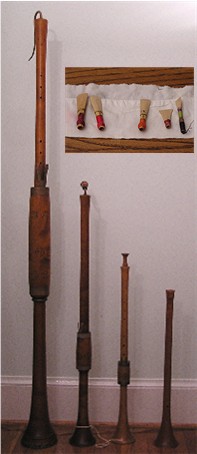Pommer

The pommer , also known as the bombarde , is a woodwind instrument with a double reed and conical bore that was developed from the shawm at the beginning of the 15th century and was played in both art and folk music. The unbent sound tube consists of one piece. It has six to seven finger holes , next to one to four flaps, protected by a barrel-shaped capsule, the so-called fontanel . Higher registers are provided with a pirouette , the bass pommer with an S-bow .
The strong, sharp tone of the Pomeranian remained particularly popular in France until the 18th century, especially for music in the open air. The oboe , largely developed by Jean de Hotteterre , replaced the shawm in the late 17th century; from the larger, deeper-sounding Pomerania contrast equivalent successor instruments emerged only in the 18th century (especially oboe da caccia , English horn and oboe d'amore ). For the performance of music of the Renaissance , replicas of the Pomeranian are mostly played today.
Surname
The instrument was initially referred to in Romance languages as bombarda, bombardo or bombarde , derived from the Latin word bombus for a deep hum or hum. In German, variants such as bombart and bumbart as well as bomhart , bumhart and pumhart developed from this - and finally the shortened form Pommer .
Some of the older word forms, such as (the) Bombarde , (the) Bombart or (the) Bomhard / Bomhart , could stick with Pommer . The designation bombarde also applies to instruments of the same type that are still played in Brittany today (see bombarde ).
Shawms (high pitches) and Pomeranian (lower pitches) together form a family of instruments. The treble instruments were usually called shawms .
Locations
Michael Praetorius lists "seven kinds of Pomeranians" in his list of musical instruments, which he also calls "Pommer and shawms" (Part 2 of the Syntagma musicum , 1619):
- Small treble (h'-h '') - Praetorius calls this instrument Gar klein Schalmey (cf. the designation Garklein recorder )
- Treble (d'-a '') - Praetorius calls this instrument Schalmey
- Small-old (g – d '')
- Upper-Alto or Nicolo (c – g ')
- Tenor (G – g ')
- Bass (C-h)
- Big bass
The division according to Praetorius does not apply to all Pomerania in different regions. There were also shawms and Pomerania with other tones of voice and Tonumfängen built.
See also
- Bombarde , related musical instrument in Breton folklore
- Dulcian
- Sordun
- Tenora , tenor shawm in Catalan folklore
literature
- Walter Frei: Schalmei and Pommer: A contribution to their differentiation. In: Die Musikforschung, Volume 14, Issue July 3 / September 1961, pp. 313–316
- Barbara Neumeier: The Pommer. Construction, context, repertoire. (Saarbrücker Studies in Musicology 17), Studiopunkt-Verlag Sinzig 2015, ISBN 978-3-89564-159-6
Web links
- Renaissance instruments: Pommer Capella de la Torre, video (1:22 min.)
Individual evidence
- ↑ Duden online: Bombarde , see there the reference to Bomhart (1) . That is, one of the meanings of Bombarde is identical to meaning 1 in Bomhard / Bomhart : "medieval woodwind instrument from the shawm family".
- ↑ a b c Description of the Pommer ( Memento of the original from August 8, 2016 in the Internet Archive ) Info: The archive link was inserted automatically and has not yet been checked. Please check the original and archive link according to the instructions and then remove this notice. capella-de-la-torre.de
- ↑ Article oboe in the Encyclopædia Britannica (1911) at Wikisource (English).
- ^ Pommer in the German dictionary by Jacob and Wilhelm Grimm
- ↑ Duden online: Bomhard, Bomhart (these are two spellings of the same word form)
- ↑ Duden online, curiously enough , lists the older names Bombarde and Bomhard, Bomhart , but not the most common name Pommer today (or Pommer does not have this meaning).
